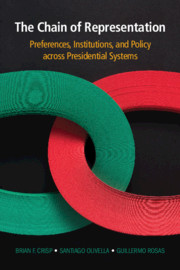Book contents
- Frontmatter
- Contents
- List of Figures
- List of Tables
- Acknowledgements
- Abbreviations
- 1 Studying the Chain of Representation
- 2 Our Solutions to the Challenges of Studying the Chain of Representation
- Part I Stages
- Part II Linkages
- Part III Testing the Chain of Representation
- 9 From Citizens to Policy-Makers
- 10 From Policy-Makers to Policies
- 11 From Citizens to Policies
- 12 A Chain Is Only as Strong as Its Weakest Link
- Appendix Question Wording
- Bibliography
- Author Index
- Subject Index
9 - From Citizens to Policy-Makers
from Part III - Testing the Chain of Representation
Published online by Cambridge University Press: 10 January 2020
- Frontmatter
- Contents
- List of Figures
- List of Tables
- Acknowledgements
- Abbreviations
- 1 Studying the Chain of Representation
- 2 Our Solutions to the Challenges of Studying the Chain of Representation
- Part I Stages
- Part II Linkages
- Part III Testing the Chain of Representation
- 9 From Citizens to Policy-Makers
- 10 From Policy-Makers to Policies
- 11 From Citizens to Policies
- 12 A Chain Is Only as Strong as Its Weakest Link
- Appendix Question Wording
- Bibliography
- Author Index
- Subject Index
Summary
The congruence and responsiveness models we have estimated paint a relatively homogeneous picture of representation in the region: although the quality of representation, as measured by the levels of both congruence and responsiveness, appears to be generally high during the period of study, there are systematic differences across institutional arrangements. These differences tend to be consistent across dimensions of the representation space: for legislatures, permissive systems tend to show high levels of both congruence and responsiveness, and the same is true for the strongest, restrictive constellations of electoral rules – a tendency that results in a U-shape relationship between electoral system strength and quality of representation. Executives, in turn, appear to be most congruent when they are elected under the least permissive rules, a pattern that results in a linear relationship between strength and congruence of all types.
- Type
- Chapter
- Information
- The Chain of RepresentationPreferences, Institutions, and Policy across Presidential Systems, pp. 171 - 193Publisher: Cambridge University PressPrint publication year: 2020



